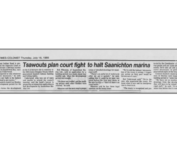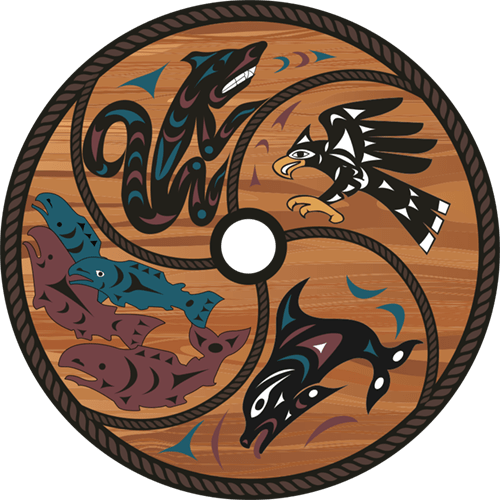
Protesters in Grace Islet row given month to prepare case
Judge delays decision on owner’s application for no-trespassing order
The owner of Grace Islet, where a home is being built over a First Nations burial site, asked a B.C. Supreme Court judge Tuesday to issue a no-trespassing order to keep protesters away.
But the judge said the issue, in which local politicians and First Nations chiefs have joined protesters, could be more complicated than trespassing and deserved more time for preparation of legal arguments and research of aboriginal rights.
“[The issue] may be as simple as the plaintiff says it is, or it may be not that simple,” Justice Douglas Thompson said.
If granted, the order would prevent people not authorized by the owner from going on the Ganges Harbour islet, going within a 50-metre radius of its dock or interfering with construction.
Thompson approved Tsartlip Chief Don Tom’s request for an adjournment of one month to prepare legal arguments and consult his community. The request was supported by others involved in the case, including Victoria Coun, Ben Issit, NPD MLA Gary Holman, Tseycum Chief Vern Jacks and activist Joe Akerman, who have been among the protesters.
Tom called the ruling a victory. “The judge recognized the importance of competing rights, that private property ownership is not exclusive or such a simple issue.”
Tom’s lawyer, Karey Brooks, said her client sees Grace Islet as a sacred burial ground and believes First Nations have rights to protect it and practise traditional ceremonies.
“My client claims this right, whether it’s characterized as a Douglas Treaty or aboriginal right. …He has a lawful and constitutional right of access to this island” she said. In the mid 1800s, the Douglas Treaties awarded Island First Nations use of traditional sites.
Brooks said her team had less than 24 hours to prepare for the hearing and needed more time.
Barry Slawsky, owner of Grace Islet, was not in court. Slawsky, an Alberta based businessman, was represented by Victoria lawyer John Alexander, who filed the no-trespassing application on Sept. 18, a day after protesters went onto the private property for the second time in recent months.
Alexander cited safety concerns over protesters trespassing or interfering with a construction site, saying children were present in one instance. He pointed to media reports in which protesters spoke of escalating action. “We know social media is powerful, it brought all these people here this morning,” Alexander said, referring to the packed courtroom.
Timeliness is an issue for his client, who wants to get the house’s roof and windows completed before winter without interruption by protesters, Alexander said.
He said his client does not oppose free speech nor the right to protest. He acknowledged the protester’s frustration.
“The province not stepping up and doing anything led the named defendants to doing what they did,” Alexander said.
Opposition to development on Grace Islet heated up in 2006 with the discovery of ancient human remains and burial cairns. First Nations, politicians and community members have lobbied the provincial government to intervene and protect the islet under the Heritage Conservation Act.
“I’ve been trying to get ahold of [Forests Minister Steve] Thomsom but he hasn’t been answering his phone,” Jacks said outside the courthouse.
He and Tom were among Chiefs called to meet ministry staff about the issue. Jacks said they had been frustrated by a lack of results.
Thomson and deputy minister Tim Sheldan did not respond to requests for comment.






